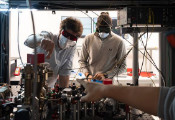Detecting and Mitigating ‘Forever Chemicals’ With a Quantum Assist
December 10, 2024 -- PFAS and PFOS "forever chemicals" are harmful compounds incorporated in industrial and consumer products that have infiltrated food and water supplies, posing serious threats to human health. Some of these chemicals can persist for decades or more in the environment, and studies suggest they may cause or exacerbate cancer, liver damage, fertility issues and a host of other health conditions.
The only known way to break PFAS chemicals down quickly is incineration at temperatures exceeding 1400 degrees Celsius — but that’s an expensive, commercially unsustainable method.
Now Professor Henry Du, Associate Dean for Research and Faculty Development in the School of Engineering and Science, and Professor Yuping Huang, director of Stevens’ Center for Quantum Science and Engineering (CQSE) have been tapped by the Environmental Protection Agency (EPA) to join a multi-university effort to detect and degrade these chemicals in new ways that could cost less — and require far less energy consumption.
“This is one of EPA’s major research grants to monitor and mitigate PFAS chemicals from both wastewater and groundwater,” notes Du, who with Huang will collaborate with Clarkson University, the University of Nebraska and SUNY-Buffalo in the effort.
New types of sensing, powered by quantum tech
Stevens’ role will be to leverage technologies from its quantum and materials science labs to co-develop innovative detection platforms and novel filtering systems with the partner universities’ teams.
The group’s proposed SENSE-PFAS system will include a suite of technologies. Specially designed and functionalized silver nanoparticles provide sites for robust adsorption and sensitive detection of PFAS chemicals; Stevens will both play a role in designing those devices and in boosting their effectiveness.
The emerging new tools of quantum science can be used to help those detection platforms achieve unprecedented sensitivity on the order of parts-per-quadrillion, say Huang and Du.
“We will be using quantum-parametric mode sorting (QPMS) methods to increase the sensitivity of the PFAS sensors,” explains Huang, “while attempting to develop a novel quantum-enhanced Raman measurement approach with some of the single-photon methods we have been developing and extending here at Stevens.”
Once detected, the next challenge will be to render PFAS safer for disposal. Certain graphene- and iron-based nanocompounds, printed into super-thin layers of sheets, have recently demonstrated to help degrade PFAS into fluoride, acetate and other less harmful substances by breaking apart the PFAS chemicals’ strong carbon-fluorine bonds through catalytic reactions. The system will leverage those properties.
“SENSE-PFAS, if fully realized, will integrate all these functions into a single system that simultaneously signals PFAS chemicals' presence and then begins breaking them down,” points out Du.
Trials of the system will take place in northern New York state, including on the tribal lands of the Mohawk Nation. The project, “Multimodal Nanosensor for Field Detection and Degradation of PFAS Contamination in Groundwater and Wastewater,” extends through July 2027.




































